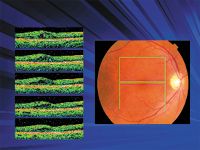Article
Spectral domain OCT opens door to better retinal images
Author(s):
Las Vegas-Spectral domain optical coherence tomography (OCT) offers major advantages to the clinician in providing high-resolution, cross-sectional images of the retina. These newly developed instruments can acquire three-dimensional (3-D) scans at a high speed and provide excellent point-to-point registration, explained Yale L. Fisher, MD, during the Retina Subspecialty Day at the American Academy of Ophthalmology annual meeting.

The technology is changing rapidly with new hardware and software. Familiarity with this technology is critical before investing in these new instruments, said Dr. Fisher, clinical professor of ophthalmology, Presbyterian New York Hospital, Cornell Weill Medical College, and attending surgeon, Manhattan Eye, Ear, and Throat Hospital, New York.
"OCT is distance-measuring equipment similar to ultrasound," Dr. Fisher said. "OCT uses light, which travels one million times faster than sound."


"Of course, there are disadvantages associated with new technology, such as the need for additional training and hardware/software alterations," Dr. Fisher said.
Hands-on experience
He recounted that his experience has involved the Topcon spectral domain 3-D OCT instrument, which uses a non-mydriatic fundus camera and can provide cross-sectional 3-D area scans. With this pre-production instrument, 128 B-scan images are delineated within a 6 by 6-mm box superimposed on a color or projection image. Registration is point to point. Any area within the box outline can be visualized in B-scan OCT via a cursor point-and-click technique. Software programs also allow 3-D images of the entire block of tissue located within the boxed area. Once acquired, the 3-D image also can be reviewed in layers, isolating the deeper or superficial layers for analysis or volume measurement, Dr. Fisher explained.
"It is possible to push the technology one step further by adding digital angiographic data to the hard drive of the OCT. Software permits image registration to the projection OCT rendering. Once accomplished, areas of leakage seen on the angiogram can be examined and correlated to point-registered B-scan OCT images," he said.
Newsletter
Don’t miss out—get Ophthalmology Times updates on the latest clinical advancements and expert interviews, straight to your inbox.




